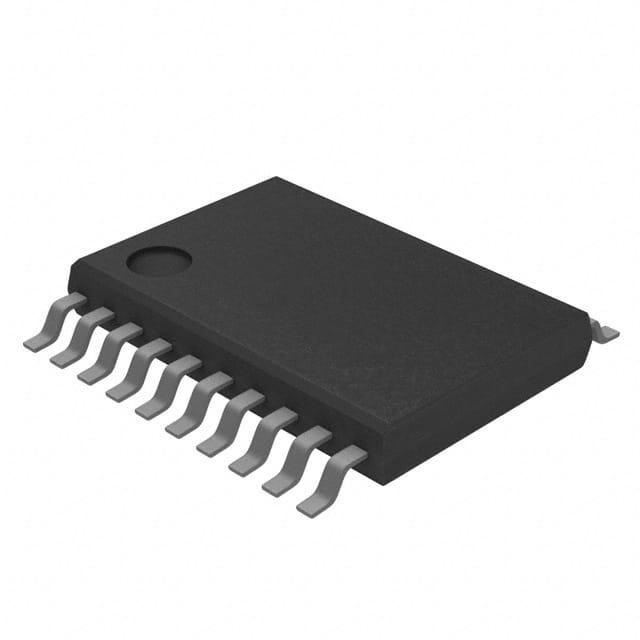Szczegóły produktu można znaleźć w specyfikacjach.

SN74LVC374APW
Product Overview
- Category: Integrated Circuit (IC)
- Use: Flip-Flop
- Characteristics: Low-voltage, high-speed, octal D-type flip-flop
- Package: TSSOP (Thin Shrink Small Outline Package)
- Essence: A versatile flip-flop IC that can store and transfer data in digital circuits
- Packaging/Quantity: Available in reels of 2000 units
Specifications
- Supply Voltage Range: 1.65V to 3.6V
- High-Level Input Voltage: 2V to VCC + 0.5V
- Low-Level Input Voltage: -0.5V to 0.8V
- High-Level Output Voltage: VCC - 0.4V
- Low-Level Output Voltage: 0.4V
- Maximum Clock Frequency: 160MHz
- Number of Flip-Flops: 8
Detailed Pin Configuration
The SN74LVC374APW has a total of 20 pins. The pin configuration is as follows:
- OE (Output Enable) - Output control pin
- CP (Clock Pulse) - Clock input pin
- D0-D7 (Data Inputs) - Data input pins
- Q0-Q7 (Outputs) - Data output pins
- GND (Ground) - Ground reference pin
- VCC (Power Supply) - Positive power supply pin
Functional Features
- Octal D-Type Flip-Flop: Can store and transfer eight bits of data simultaneously
- Low-Voltage Operation: Operates at a low voltage range of 1.65V to 3.6V
- High-Speed Operation: Supports clock frequencies up to 160MHz
- Output Enable Control: Allows for easy control of the output state
- Edge-Triggered Clocking: Data is transferred on the rising edge of the clock signal
Advantages and Disadvantages
Advantages: - Versatile flip-flop IC suitable for various digital circuit applications - Low-voltage operation allows for compatibility with modern low-power systems - High-speed operation enables efficient data transfer - Output enable control provides flexibility in output state management
Disadvantages: - Limited to octal (8-bit) data storage and transfer - Requires an external clock signal for proper operation
Working Principles
The SN74LVC374APW is an edge-triggered D-type flip-flop. It stores and transfers data based on the rising edge of the clock pulse. When the clock input (CP) receives a rising edge, the data present at the D0-D7 inputs is latched and transferred to the corresponding Q0-Q7 outputs. The output enable (OE) pin controls the output state, allowing the user to enable or disable the data outputs.
Detailed Application Field Plans
The SN74LVC374APW can be used in various digital circuit applications, including but not limited to:
- Microcontrollers: Used for storing and transferring data in microcontroller-based systems.
- Memory Systems: Employed in memory modules to store and retrieve data efficiently.
- Communication Systems: Utilized in communication devices for data buffering and synchronization.
- Data Processing Units: Integrated into data processing units to facilitate data manipulation and storage.
Detailed and Complete Alternative Models
- SN74LVCH374APW: Similar to SN74LVC374APW, but operates at a wider voltage range of 1.2V to 3.6V.
- SN74ACT374PW: A TTL-compatible alternative with higher operating voltage range (4.5V to 5.5V).
- SN74HC374N: A CMOS-based alternative with a wider temperature range and lower power consumption.
(Note: This is not an exhaustive list of alternative models. Please refer to the manufacturer's documentation for a complete list.)
In conclusion, the SN74LVC374APW is a versatile flip-flop IC that operates at low voltage and high speed. It is commonly used in digital circuits for data storage and transfer. With its edge-triggered clocking and output enable control, it offers flexibility and efficiency in various applications.
Wymień 10 typowych pytań i odpowiedzi związanych z zastosowaniem SN74LVC374APW w rozwiązaniach technicznych
Sure! Here are 10 common questions and answers related to the application of SN74LVC374APW:
Q: What is SN74LVC374APW? A: SN74LVC374APW is a type of octal D-type flip-flop integrated circuit (IC) that can be used in various technical solutions.
Q: What is the purpose of SN74LVC374APW? A: The purpose of SN74LVC374APW is to store and manipulate digital data in electronic systems.
Q: What is the voltage range supported by SN74LVC374APW? A: SN74LVC374APW supports a voltage range of 1.65V to 5.5V.
Q: How many flip-flops are there in SN74LVC374APW? A: SN74LVC374APW consists of 8 flip-flops, making it an octal (8-bit) device.
Q: What is the maximum clock frequency supported by SN74LVC374APW? A: SN74LVC374APW can operate at a maximum clock frequency of 100 MHz.
Q: Can SN74LVC374APW be used for both input and output operations? A: Yes, SN74LVC374APW can be used as both an input and output device, depending on the application.
Q: What is the power supply requirement for SN74LVC374APW? A: SN74LVC374APW requires a power supply voltage between 2.7V and 3.6V.
Q: Does SN74LVC374APW have any built-in protection features? A: Yes, SN74LVC374APW has built-in protection against electrostatic discharge (ESD) and excessive power dissipation.
Q: Can SN74LVC374APW be used in high-speed data transfer applications? A: Yes, SN74LVC374APW is designed for high-speed operation and can be used in applications requiring fast data transfer.
Q: What are some typical applications of SN74LVC374APW? A: SN74LVC374APW is commonly used in microcontrollers, digital signal processors, memory systems, and other digital logic circuits.
Please note that these answers are general and may vary depending on the specific requirements and use cases of your technical solution.

